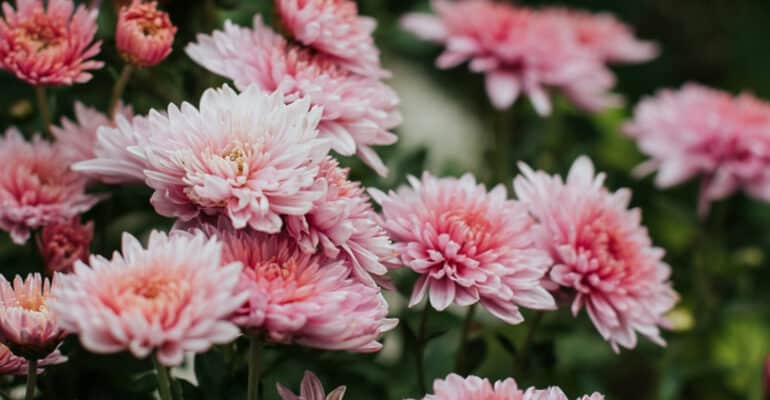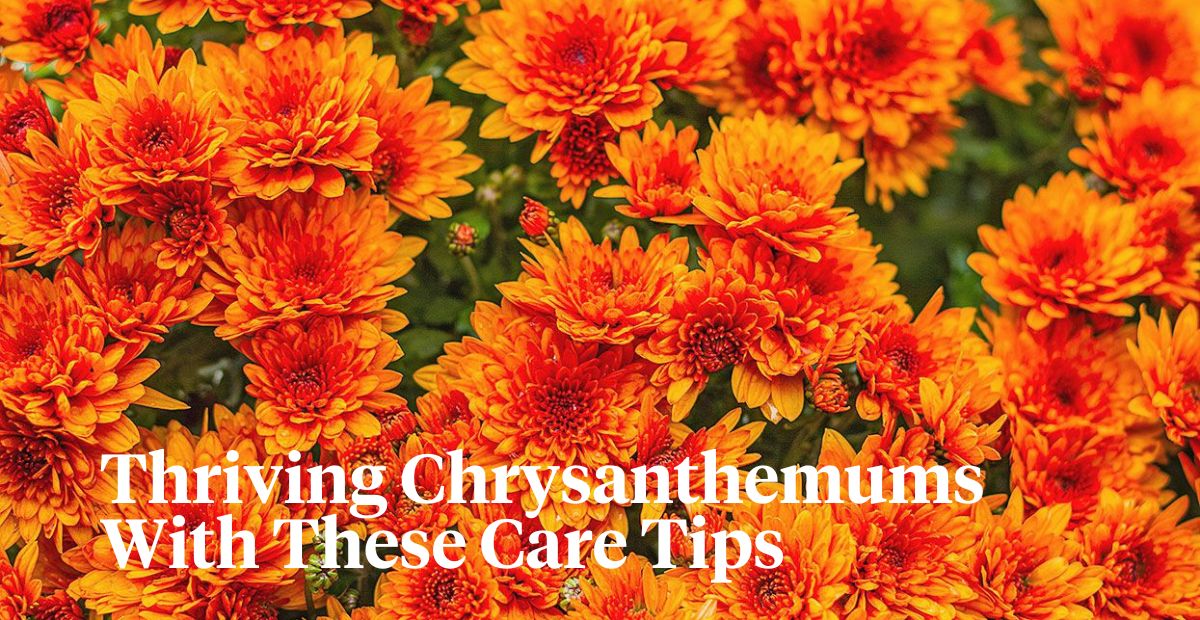The Basics of Chrysanthemum Care: Getting Started
Proper care is essential for chrysanthemums to thrive and provide vibrant colors to your garden. Healthy growth, blooming, and pest resistance are just a few benefits of mastering chrysanthemum care. By understanding how to care for chrysanthemums, you can enjoy their stunning flowers for years to come. In this article, we will guide you through the process of selecting the right variety, planting, nourishing, and protecting your chrysanthemums. Whether you’re a seasoned gardener or a beginner, this comprehensive guide will provide you with the knowledge on how to care for chrysanthemums and bring joy and color to your garden.
Choosing the Right Chrysanthemum Variety for Your Climate
With numerous types of chrysanthemums available, selecting the right variety for your region’s climate and growing conditions is crucial for optimal growth and blooming. Hardy, florist, and garden varieties are the three main categories of chrysanthemums, each with its unique characteristics and requirements. Hardy chrysanthemums are ideal for outdoor gardens, while florist varieties are typically used for cut flower arrangements. Garden varieties, on the other hand, offer a range of colors and bloom sizes. When choosing a variety, consider factors such as temperature tolerance, moisture levels, and sunlight requirements. For instance, if you live in a region with harsh winters, opt for a hardy variety that can withstand frost. By selecting the right chrysanthemum variety, you’ll be well on your way to mastering how to care for chrysanthemums and enjoying their vibrant blooms in your garden.
How to Plant Chrysanthemums for Optimal Growth
Planting chrysanthemums is a crucial step in mastering how to care for chrysanthemums. To ensure optimal growth, it’s essential to prepare the soil, choose the right location, and handle the plants correctly. Start by selecting a location that receives full sun to partial shade, depending on the variety. Chrysanthemums prefer well-draining soil with a pH between 6.0 and 7.0. Before planting, mix in organic matter such as compost or manure to improve soil fertility and drainage. When planting bare-root chrysanthemums, soak the roots in water for 24 hours before planting. For potted chrysanthemums, gently remove the plant from the pot and loosen the roots. Plant the chrysanthemum at the same depth as it was in the pot, and water thoroughly. Space chrysanthemums 18-24 inches apart to allow for proper air circulation and growth. By following these steps, you’ll be well on your way to growing healthy and thriving chrysanthemums.
Nourishing Your Chrysanthemums: Fertilization and Watering Tips
Proper fertilization and watering are essential components of how to care for chrysanthemums. Chrysanthemums require a balanced fertilizer that is high in phosphorus to promote healthy root growth and blooming. Apply a slow-release fertilizer in the spring when new growth appears, and follow up with a liquid fertilizer once a month. When it comes to watering, chrysanthemums prefer moist soil, but be cautious not to overwater. Check the soil daily, and water only when the top inch of soil feels dry to the touch. Avoid getting water on the leaves or flowers to prevent fungal diseases. In terms of frequency, water chrysanthemums deeply once or twice a week, depending on weather conditions. By following these fertilization and watering tips, you’ll be able to provide your chrysanthemums with the necessary nutrients for optimal growth and blooming.
Pest and Disease Management: Common Issues and Solutions
When it comes to how to care for chrysanthemums, pest and disease management is a crucial aspect to consider. Chrysanthemums are susceptible to various pests and diseases that can hinder their growth and blooming. Common pests that affect chrysanthemums include aphids, whiteflies, and spider mites. These pests can be managed using organic methods such as neem oil and insecticidal soap, or chemical pesticides like pyrethrin. Regularly inspecting your plants and taking action at the first sign of infestation can help prevent the spread of pests.
In terms of diseases, chrysanthemums are prone to powdery mildew, root rot, and leaf spot. These diseases can be caused by fungal infections, bacterial infections, or viral infections. To manage diseases, it’s essential to maintain good garden hygiene, remove infected plants, and improve air circulation. Fungicides and bactericides can also be used to treat infected plants. By being aware of these common pests and diseases and taking proactive measures, you can ensure your chrysanthemums remain healthy and thrive.
Pruning and Deadheading: Encouraging Blooms and Healthy Growth
Pruning and deadheading are essential techniques for how to care for chrysanthemums, as they promote healthy growth and encourage blooming. Pruning involves cutting back stems to maintain shape, encourage new growth, and increase flower production. To prune chrysanthemums, cut back stems to about 4-6 inches from the ground in late winter or early spring, before new growth begins. This will help control the plant’s height and promote bushy growth.
Deadheading, on the other hand, involves removing spent flowers to encourage the plant to produce more blooms. To deadhead chrysanthemums, simply snip off the faded flowers at the base of the stem, making sure not to damage the surrounding foliage. This will help direct the plant’s energy towards producing new flowers rather than seed production.
By incorporating pruning and deadheading into your chrysanthemum care routine, you can enjoy a more vibrant and blooming display of flowers. Remember to prune and deadhead regularly to maintain the health and appearance of your plants. With these simple techniques, you’ll be well on your way to mastering how to care for chrysanthemums and enjoying their beautiful blooms all season long.
Protecting Your Chrysanthemums from Extreme Weather Conditions
Chrysanthemums are sensitive to extreme weather conditions, which can cause damage or even death. To ensure the health and longevity of your plants, it’s essential to take steps to protect them from harsh weather. When it comes to how to care for chrysanthemums, protecting them from frost is crucial. If you live in an area with frost, bring potted chrysanthemums indoors or move them to a frost-free area. For in-ground plants, apply a layer of mulch or straw to insulate the soil and protect the roots.
Heatwaves can also be detrimental to chrysanthemum health. To protect your plants from heat stress, provide shade during the hottest part of the day, and ensure they receive adequate water. Strong winds can cause damage to stems and flowers, so provide support using stakes or trellises to keep your plants upright.
In addition to these measures, it’s essential to monitor weather forecasts and take action before extreme weather conditions occur. By being proactive and taking steps to protect your chrysanthemums, you can ensure they remain healthy and thrive, even in challenging weather conditions. By following these tips, you’ll be well on your way to mastering how to care for chrysanthemums and enjoying their beautiful blooms all season long.
Common Mistakes to Avoid When Caring for Chrysanthemums
When it comes to how to care for chrysanthemums, avoiding common mistakes is crucial for promoting healthy growth and encouraging blooms. One of the most common mistakes is overwatering, which can lead to root rot and other problems. To avoid this, check the soil regularly and only water when it feels dry to the touch.
Underwatering is another common mistake that can cause chrysanthemums to become stressed and susceptible to disease. Make sure to water your plants regularly, especially during hot and dry weather. Inadequate pruning is also a common mistake that can lead to leggy growth and reduced blooming. Regular pruning helps to promote bushy growth and encourages more blooms.
Other common mistakes include failing to provide enough sunlight, not fertilizing regularly, and not protecting plants from extreme weather conditions. By being aware of these common mistakes and taking steps to avoid them, you can ensure your chrysanthemums receive the care they need to thrive. By following these tips and avoiding common mistakes, you’ll be well on your way to mastering how to care for chrysanthemums and enjoying their beautiful blooms all season long.



:max_bytes(150000):strip_icc()/fall-garden-mums-hardy-or-no-1402718-04-bbc5a2186d8640e2b4b5bc4036b892bc.jpg)



